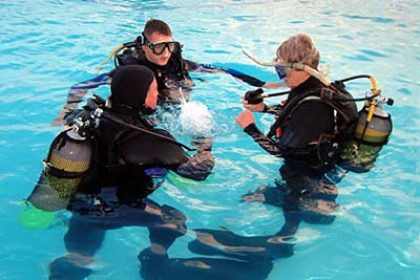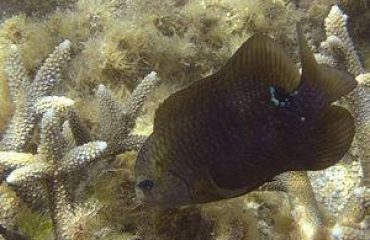Top 10 Newbie Diving Mistakes | What not to do when you’re learning to dive

We’ve all been there — when you’re a new diver, it’s easy to make inadvertent mistakes. Here are 10 to avoid as you hone your underwater skills.
1. Skipping the Buoyancy Check
Whether you are over-weighted or under-weighted while diving, it happened because you didn’t do a buoyancy check at the surface. If anything has changed since your last check — weight loss or gain, new wetsuit or different thickness, fresh water instead of salt water, new or different BCD — then you need to do another one to make sure that you’re weighted properly. The wrong weights can cost you precious energy and air at best, or cause an out-of-control ascent at worst.
2. Diving Outside Your Training Limits
It’s easy to get swept up in the excitement of a new dive site, and to feel like you’ll be fine because you’ve got someone with you who has more advanced training. This is often a big mistake. Most diving accidents happen because a diver was not properly prepared for the conditions in which they were diving. Don’t ever think that additional training or experience is a waste of money or time. Every year, divers who have never taken a wreck, cave or cavern class die inside cave systems. Nearly as often, divers without proper training die inside the overhead environment of wrecks, too. Get proper training before attempting any dive above your skill level.
3. Lack of Buddy Communication
Whether it’s your friend or a family member, or even an insta-buddy, communication is essential. From early training classes on, I see divers who don’t even know where their buddy is at any given time. Keeping tabs on the person who may be called upon to help save your life — or whose life you may have to save — should be your top priority. Go over your hand signals so there’s less confusion down below; keep a watchful eye on your buddy’s location so you always know how far away they are; and keep tabs on their air as well as your own.
4. Lack of Situational Awareness
New divers tend to focus on one or two specific things, such as their equipment or the marine life, and miss the bigger picture. This is understandable, but it’s also dangerous. While you’re staring at the pretty fish or fussing with your mask, you may be getting pushed down current and lose the group or the boat. One of the most common issues involves new divers being unaware of their depth. Wall dives in particular are notorious for this, as divers stare at the wall and marine life and don’t pay attention to an unnoticed descent. In some places, a down current could push divers down, and far past recreational limits if they’re not careful. Lack of situational awareness is also an issue when divers swim with their arms, as they’re often unaware of other divers nearby.
5. Not Watching Air Consumption
New divers are famous for completely ignoring their air-pressure gauge, which is frightening since air is the single most important thing to a diver. I try to train my students to keep such a close watch on their air that when I ask them how much they have, they shouldn’t have to look to know. Watch your air and know at all times how much you have — there is absolutely no excuse for neglecting this. After your dives, chart your air consumption so that on future dives in similar conditions you’ll be able to estimate how much air you’ll need
6. Straining on the Surface
New divers always seem to forget they can inflate their BCD at the surface and just kick back and relax. My students often struggle to tread water after surfacing, even if they inflate their BCD. They often continue to kick out of sheer instinct, tiring themselves out in the process. Diving gear is uncomfortable on the surface, so it may take some practice to learn to relax with it. Your best bet is to inflate your BC enough so that you can lean back slightly and relax your legs.
7. Using the Power Inflator Too Much Underwater
While many newer divers tend to forget about inflating their BCD at the surface, they never seem to forget about it underwater. Inflate, deflate, inflate, deflate — that seems to be the habit of most new divers instead of learning good buoyancy control. It practice to perfect, but that’s difficult to do if you’re always reaching for your power inflator.
8. Task Loading
You’re on a beautiful reef with spectacular marine life, so it makes sense that you want to take pictures. But newer divers already have a lot to deal with — adding more can be detrimental. I’ve seen divers on their first open water dives, alone in a brand new environment, wearing new equipment and carrying expensive cameras and lighting equipment. Try not to do too much at once when you’re still learning new habits. Once you have a few dives under your belt in various conditions, and are familiar with your new dive gear, then break out the fancy camera equipment and fire at will.
9. Not Equalizing Soon Enough
Despite going over and over it in class, many new divers still wait until they feel pain or pressure before equalizing. Aside from physical problems in the ears, this is the most common reason divers have difficulty equalizing in the first place. Once you’re experiencing pain, it’s going to be difficult, if not impossible, to equalize your ears. Even trying to do so could cause irritation and inflammation, making it even harder on the next dive. Equalize every couple of feet on your way down, before you feel pain or pressure, and especially in the first 30 feet. If you do feel pain, ascend a little and then try to equalize. Don’t force it; you could end up causing damage.
10. Relying Solely on a Guide
I understand if you don’t want to learn how to navigate with a compass, or try to figure out the best dive pattern for a dive site, but placing all of your trust in a guide and neglecting to pay any attention to where you are is dangerous. I’ve seen divers completely ignore dive briefings about currents, marine life, bottom times and depth limits because they feel they don’t need to think about any of that since they have a guide. I’m not claiming that the trust is misplaced, only that every diver must be responsible for himself even if he is relying on a guide to show him around. Pay attention during the dive briefing; take notice of landmarks and directions while swimming; be an active participant in your own dive adventure and responsible for your own safety. Doing so will help keep you and the people with you safer, make the journey more enjoyable, and make you a better diver. By Shelley Collett WRITER





